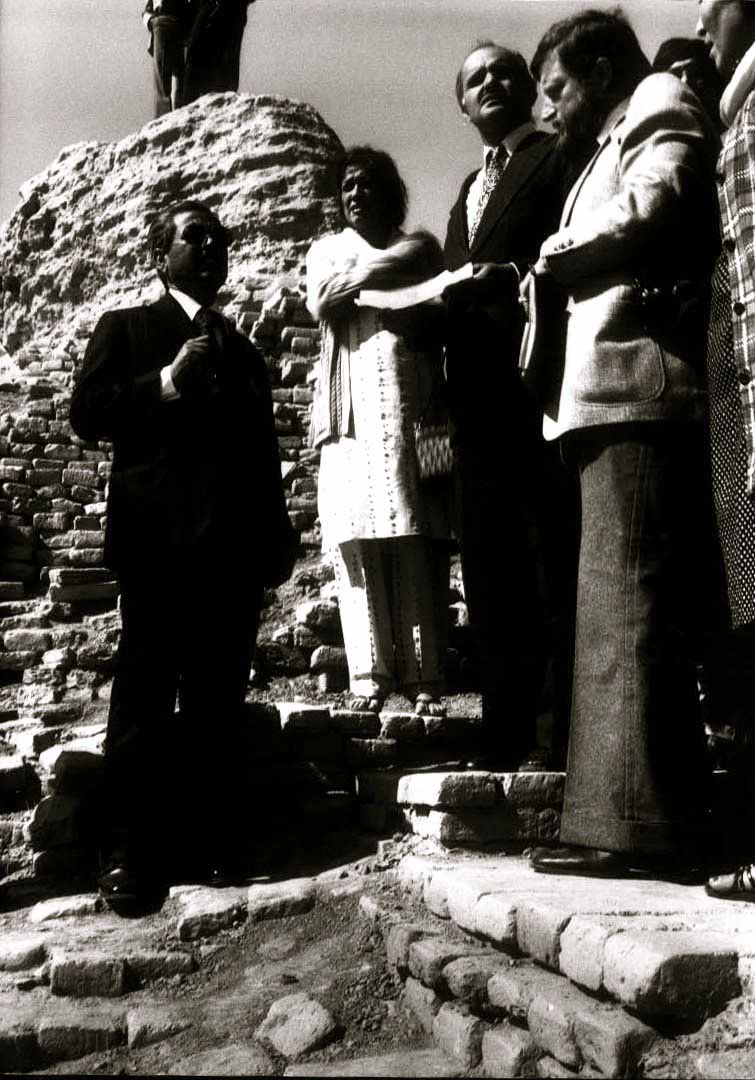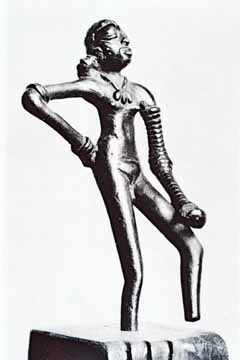Moenjodaro
Another gentleman whom we had never met, but who arrived at our house to seek my wife’s help to build in mud was Prof. Dr. Michael R. N. Jansen of RWT University of Aachen in Germany. He arrived one evening with his wife and members of his team, who had come to document and review the work done at Moenjodaro and had to live there in tents. Those who are quick to offer tents to people affected by various calamities do not know how painful it is to live in them, where the temperature soars to its highest point at noon and drops to its lowest at midnight. My wife readily agreed, but warned him that he would not get permission to build in mud. This is what happened, and their hope of living in comfortable mud houses never materialized. However we became friends, and criticized him for not teaching Pakistanis the latest methods and technology in documentation developed in Germany, and for taking all the information that they collected to Germany, which in no way benefitted Pakistani architects and archaeologists. Michael immediately agreed to take Pakistanis who would be willing to work at Moenjodaro with him, and also offered to help us document the old mud architecture of Thatta.
My wife, who was taking evening classes at the school of architecture in Karachi selected her brightest students to work with the Germans in Moenjodaro; but they could not bear living in tents and working under the sun, and vanished from Moenjodaro after a few days. However my son, Mihail, who was a student of Karachi Grammar School, worked during his holidays with them in Moenjodaro. Mrs. Yasmeen lari also went there to see at first hand the work that the Germans were doing, and lived in a tent.
After that Michael came every year to deposit his things at our house for safekeeping on his way back to Germany in the summer and came in the winter to collect them on his way to Mohenjo-Daro. Before he came, Michael phoned from Aachen to ask if we needed anything from Germany and brought black bread and black coffee for us. We often arranged for his team lectures, seminars and dinner receptions in our Garden and one year a German parliamentary delegation came to dinner reception in our Garden and awarded a medal to us, which I have yet to decipher.
Our friendship with the German professor ended when I sent an e-mail on 31 October 2013, which said, “Dear Madam As required by you the email address of Michael is [email protected] and phone number is +49.241.8095.073. I have told him that you may be contacting him. Suhail”. I followed it by another e-mail on 5 November 2013, assuring her that he is no fake, “Univ.-Prof. Dr. Michael Jansen is UNESCO Senior Expert. He holds Chair for Conservation and Heritage Management at the German University of Technology GTECH, Muscat, Oman. And is Director Aachen Conservation and Documentation Center (ACDC) at the faculty of architecture - Aachen University . Suhail”
I had introduced him to the power elite in the hope that it would lead to some good for heritage. But it ended in his never leaving the marble palace and its comforts on his visits to Pakistan. His excuse was that they were prisoners as the security situation never allowed them to move out to our house as they regularly did in the past such is the magic of money and power to all hungry humans, Europeans or Asians.
The earliest farming settlement, cultivating plants (wheat and barley) and domesticating animals (sheep, goat and cattle) have been discovered at Mehrgarh in Baluchistan in South Asia, dating from 7000 BCE. The earliest evidence of pottery in South Asia is also found there from 5500 BCE. Between 5000 and 4000 BCE, farming communities spread into Sindh, Punjab and Northern India. Their inhabitants migrated to the fertile valleys of the Indus and Saraswati rivers, and developed a well-organized, and highly advanced civilization by 2800 BCE. They were the first to have central urban planning that had well organized wastewater drainage systems, trash collection systems, public granaries and baths. They also developed the first accurate system of weights and measures. Their economy was based on trade. Therefore most city-dwellers were artisans and merchants, as flood deposits gave them a large agricultural surplus. They used bullock carts of the kind that are still used in South Asia, and developed boats with sails. They had a massive dredged canal and docking facility in the coastal city of Lothal. The Indus civilization contradicts the hydraulic despotism hypothesis of the origin of state; as there is no evidence there of kings, palaces, armies, slaves and forced mobilization of labour nor of gods, goddesses, priests and temples. Around 1900 BCE, signs of a gradual decline begin to emerge, and by around 1800 BCE, most of the cities were abandoned. The satellite photographs have revealed the dry bed of a big river, with the width at some places of six kilometers, from the Shivalik Mountains near Simla up to the Ran of Kuchh. In the Vedas, there are references to such a big river named Saraswati, to which the rivers Yamuna and Sutlej used to flow. However, the geological changes diverted the Sutlej River towards the Indus, and the Jamuna river towards the Ganges, following which the Saraswati River no longer had enough water to reach the sea, and dried up in the Thar Desert. However, according to the Puranas, Saraswati hid herself out of shame because of the indiscretion of a priest and went underground, meeting the Ganges and Jamuna at Triveni Sangam at Allahabad.
The Saraswati River, now dried up, ran parallel to and east of the Indus River. About 96 sites have been discovered around the Indus and its tributaries, while about 500 sites have been discovered along the dried-up Saraswati River and its tributaries. According to another calculation, nearly 2,000 of the 3,000 Harrapan sites discovered so far are located outside of the Indus river valley. And more than 70 per cent of the sites are located on the banks of what was the Saraswati river. When the Saraswati dried up, the civilisation collapsed. Archaeologists now reject the view that the Indus civilization was destroyed by the Aryans, preferring to say that they came in after the end of that civilization. However, there are no written records before the third century BC except for the Indus Valley seals, which remain unreadable. And after the Aryan invasion or migration, literacy was wiped out, and did not reappear for another 1,000 years, when they got scripts from abroad from traders in the south in the shape of Brahmi and conquerors in the north in the form of Kharoshti (Khar washti-noise of donkey).


